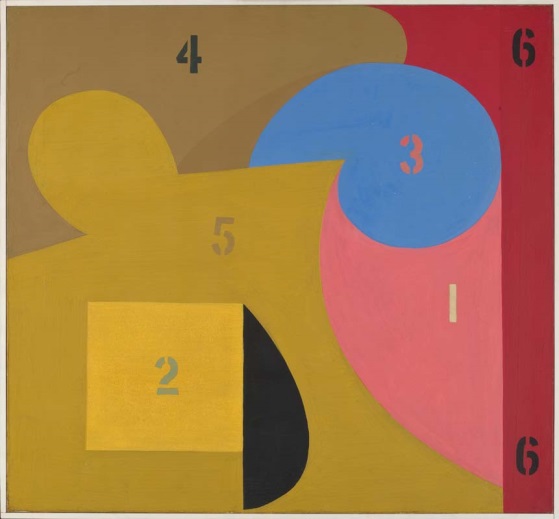We acknowledge the Traditional Owners of the land on which the Queensland Art Gallery | Gallery of Modern Art stands and recognise the creative contribution First Australians make to the art and culture of this country.

Ian Burn / Australia 1939–93 / Re-ordered painting 1965 / Oil on canvas / 80.4 x 90.5cm / Purchased 1995 with the assistance of the Queensland Art Gallery Functions Reserve Fund / Collection: Queensland Art Gallery / © QAG
Ian BurnRe-ordered painting 1965
Not Currently on Display
Re-ordered painting 1965 is among the key works of Burn’s thirty-year career. It explores the relationship between two distinct ways of reading a work of art: the intuitive response to the aesthetic arrangement of pictorial elements, and the interpretation of the work according to an imposed rationale.
In visual terms the work is rhythmic, animated and unstable, but the bluntly objective system of numbering the compositional elements undercuts the viewer’s confidence about how to read it.
This watershed work preceded several major developments in Australian art of the following 25 years, including the hard-edged abstraction, colour field and minimalist styles of the late 1960s and early 1970s, the Conceptual art of the 1970s, and the intellectual agendas of artists such as Imants Tillers and John Nixon in the 1980s.
Ian Burn was born in Geelong, Victoria and was a carpentry apprentice there for four years. He studied at the National Gallery of Victoria School where he won the Best Painting prize in 1961 and the Gallery Society Drawing Prize in 1962.
In 1964 Burn and his wife Avril left for Europe, settling in London in 1965 but moving to New York City two years later. His work was included in the pivotal 1968 exhibition ‘The Field’ at the National Gallery of Victoria, and his writings in the journal Art and Language in the years following brought him international recognition in the area of conceptual art. He stopped creating art, however, and returned to Australia in 1977.
In the 1980s he became involved in the trade union movement, and his beliefs about art shifted from thinking of it as a purely philosophical pursuit to it being a more sociological one. In 1989, after almost two decades of not making art objects, he began overlaying amateur paintings with analytical texts on sheets of glass.